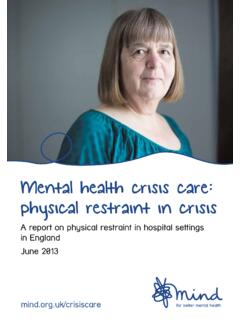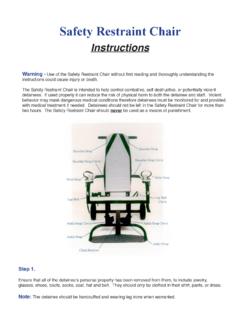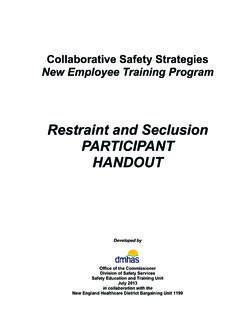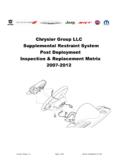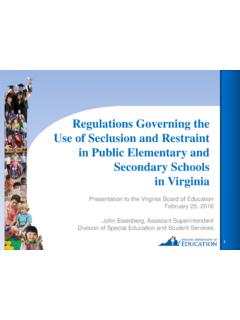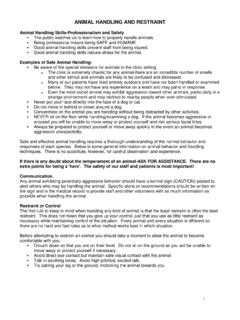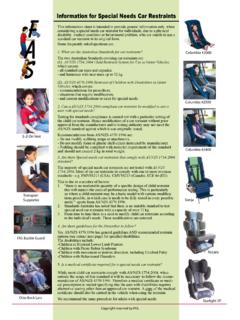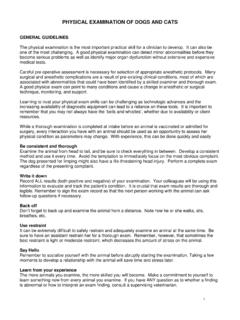Transcription of How Safe Is the Schoolhouse? - autcom.org
1 How Safe Is the Schoolhouse? An Analysis of State Seclusion and Restraint Laws and Policies Author: Jessica Butler State Restraint and Seclusion Laws, Regulations, Rules , and Policies effective December 31, 2016. The brief Quick Bullet Summary at the beginning provides a short overview of state laws and policies. Copyright Jessica Butler 2017 (all rights reserved) This report is designed to be shared. Please feel free to share, post, and redistribute this report with anyone with two conditions. First, please do not remove my name or email address from the report. Second, if you wish to use information from the report to write/create other materials, please follow the policy on page i (next page) and credit Jessica Butler, The report is updated regularly, as appropriate. Published by Autism National Committee (AutCom) Link is ( report free of charge) A U T C O M Jessica Butler Jan. 8, 2017, Important Introductory Information About the Report.
2 This report was revised in 2017 to discuss new state restraint and seclusion statutes, regulations, rules, and policies. It includes all laws in effect as of December 31, 2016. This updates earlier versions of the report, which have been published since 2012. The report presents research analyzing and comparing state approaches to restraint and seclusion that may be helpful to parents, professionals, educators, people with disabilities, and advocates. Important Technical Details (Read this!). (1) I use 51 states to include the District of Columbia. I did not have territorial materials. (2) For brevity, the term laws refers to both statutes and regulations. Both are legally binding, and thus differ from nonbinding policies and guidelines, which are only suggestions. (3) The report indicates whether a law applies to all children or only those with disabilities. A superscripted d (d) means the rules apply only to students with disabilities (students in special education).
3 A superscripted m (m) means the state has a mix of disability-only and all-children laws. If there is no symbol, the law applies to all children. (4) I have included the laws and other resources I used in a bibliography, to avoid a blizzard of law review style footnotes. (5) All information in the maps and charts is in the text. The report seeks to maximize access by people of all abilities. Some cannot see visuals or otherwise need text. Some need visuals. Where possible, the colors on maps will reflect differences when printed in black and white. Technology was limited; there is no funding underwriting this work. (6) Some states are followed by (2015) or (2016). This simply signifies that a state has recently updated its laws. Important Copyright Information. HOW SAFE IS THE SCHOOLHOUSE? is copyrighted by Jessica Butler. It represents hours of research and work that I hope adds knowledge about restraint and seclusion. You may copy, share, and distribute the report, as long as you follow these conditions.
4 Please do not remove my name and email address from the report. If you copy or extract parts of the report (including the maps), please leave my name and email address on them. If you use information from the report in creating/writing other materials, please credit Jessica Butler, I understand that the media and other publications need to credit it different and am happy to work with you on any reasonable plan for credit if you contact me. It is always fine to repost the report in full in .pdf format. It is also fine to use a fair, reasonable, and small amount of my report material in your papers, blogs, and other documents, as long as you credit it me and include either a link to the report or my email address alongside it. Unfortunately, a few individuals and organizations have tried to take significant parts of my research and use it to populate their own maps, websites, documents, or other materials, often offering to give me a small note of credit.
5 This is not acceptable without getting my separate signed written permission--even if you intend to credit me. I can fax or email permissions same day if needed. I apologize that I have to write this; most people are fair and do the right thing. If you have questions or want permission for a project or article, please just ask me. I give permission to many requesters, or I can explain why a proposed use would violate my copyright. Thank you very much for understanding. It deeply distresses me that I Jessica Butler Jan. 8, 2017, must write something like this in my report, and I wish I did not have to. About the Author. Jessica is the mother of a child with autism and an attorney. She previously coordinated Congressional affairs for the Autism National Committee ( ). AutCom has worked for over 25 years to eradicate the use of abusive interventions upon people with autism and other disabilities. Before that, she served as Chair of the Board of Directors of the Council of Parent Attorneys and Advocates (COPAA), on COPAA s Board of Directors for several years, and was a primary coordinator of COPAA s Congressional affairs efforts.
6 She is the author of UNSAFE IN THE SCHOOLHOUSE: ABUSE OF CHILDREN WITH DISABILITIES (COPAA 2009), which describes over 180 cases in which students were subjected to restraint and seclusion. This report, HOW SAFE IS THE SCHOOLHOUSE?, was authored entirely by Jessica Butler and represents only her views and work. It is not a statement on behalf of AutCom or any entity, organization, or person, and is not owned by AutCom. It is owned by Jessica. You can email Jessica at The current report is available free of charge on AutCom s webpage, , and no one should charge you money for a copy. Information from HOW SAFE IS THE SCHOOLHOUSE? has been featured in various national and state media reports, including the major news networks and major American newspapers and magazines. Jessica Butler Jan. 8, 2017, How Safe Is the Schoolhouse? An Analysis of State Seclusion and Restraint Laws and Policies December 31, 2016 Table of Contents IMPORTANT INTRODUCTORY INFORMATION AND COPYRIGHT QUICK BULLET I.
7 8 Background .. 8 A. State Changes in 2014-2016 ..11 B. General Framework for State Laws, Regulations, and Policies ..11 STATES WITH MEANINGFUL PROTECTIONS FROM RESTRAINT & SECLUSION. 13 Meaningful Protections from Restraint and Seclusion in State Law .. 15 A. Delaware: Using the State Supervisory Process to Protect Children .. 17 B. Arkansas: Legal Protection from One but Not the Other .. 17 C. Weak Protections in Law .. 18 D. Non-Binding Guidance (No Legal Effect) .. 18 E. States with Nothing (Neither Laws nor Voluntary Policies) .. 20 RESTRAINT AND SECLUSION: STATES USING THEM AS EMERGENCY PRACTICES FOR IMMINENT THREATS OF PHYSICAL DANGER .. 24 Restraint .. 24 A. Seclusion: Definition .. 35 B. State Limits on Seclusion .. 39 C. States Explicitly Forbidding Use for Punishment and Discipline .. 54 D. Steps States Take to Ensure Restraint and Seclusion are Used Only in Emergencies .. 54 E. Jessica Butler Jan. 8, 2017, IV.
8 Other Limits on Use of Restraint and Seclusion .. 63 Banning Certain restraints .. 63 A. Continuous Visual Observation of Seclusion .. 73 B. Minimum Room Condition Requirements .. 77 PARENTAL NOTICE, AWARENESS OF RESTRAINT, DATA, AND RELATED ISSUES .. 82 Informing Parents of Restraint and Seclusion ..82 A. State Debriefing Requirements ..93 B. State Requirements for Data Collection and Sunshine ..94 C. Training and Related Matters ..99 A Study of the Effect Congressional Models Have Had on State Restraint and Seclusion Laws and Policies .. 92 Congressional Models and State Requirements ..92 A. Additional Provisions That Advance Greater Safeguards For Children ..96 CONCLUSION .. 103 VIII. BIBLIOGRAPHY OF STATE MATERIALS AND SUMMARY OF STATE LAWS, REGULATIONS AND POLICIES ABOUT RESTRAINT AND SECLUSION .. 104 Note: The following page is a list of the maps and charts in the report and the pages on which they appear. Jessica Butler Jan.
9 8, 2017, Charts and Maps in Report Map or Chart Title Page Map 1: States with Meaningful Protections by Law from Both Restraint and Seclusion for Children with Disabilities 12 Map 2: States with Meaningful Protections by Law from Both Restraint and Seclusion for All Children 13 Chart 1: Does State Law Provide Meaningful Protections? 20 Map 3: States Limiting Restraint to Emergency Threats of Physical Harm: 19 States (All Children) and 23 states (Children with Disabilities) 29 Map 4: Number of States Limiting Restraint to Emergencies Threatening Physical Danger Grew Considerably from 2009 to 2016 30 Chart 2: Is Restraint Limited to Immediate Emergency Threats to Physical Safety By Law? 31 Map 5: 38 States Would Define Seclusion as Rooms/Spaces Child Cannot Exit 37 Map 6: States Banning Some Form of Seclusion 48 Map 7: States Banning Non-Emergency Seclusion 49 Map 8: States that Ban Seclusion and States that Restrict it to Emergencies Threatening Physical Harm: For All Children 50 Map 9: States Banning Seclusion or Limiting Seclusion to Emergency Threats of Physical Harm: For Children with Disabilities 51 Map 10: Number of States Prohibiting Non-Emergency Seclusion Grew Considerably from 2009 to 2016 52 Map 11: States Forbidding Restraint & Seclusion if Less Restrictive Interventions Would Resolve the Issue 60 Map 12: State Laws Requiring Restraint/Seclusion to End When the Emergency Ends 61 Map 13: Children with Disabilities: States Banning restraints that Impair Breathing and Prone Restraint 65 Map 14: All Children.
10 States Banning restraints that Impair Breathing and Prone Restraint 66 Map 15: States Banning Mechanical Restraint 70 Map 16: States Prohibiting Chemical Restraint 71 Map 17: States Forbidding Unobserved Seclusion for Children with Disabilities 75 Maps 18A-18D: States with Requirements to Improve Seclusion Room Safety 79 Chart: Parental Notification Laws At a Glance (Dec. 31, 2016) 82 Map 19: Majority of States Urge Informing Parents in 1 School Day or Less, By Law or Nonbinding Policy 88 Map 20: For Children with Disabilities: State Requires Notification in 1 School Day or Less, Broken Down by Timeline 89 Map 21: States Requiring Parental Notification within 1 School Day or Less: 2016 Compared to 2009 91 Map 22: State Requires Data Collection at State or Local Level 97 Jessica Butler Jan. 8, 2017, QUICK BULLET SUMMARY OF STATE RESTRAINT AND SECLUSION LAWS ( December 31, 2016) Seclusion and restraint are dangerous practices; children have suffered death, injury, and trauma.
